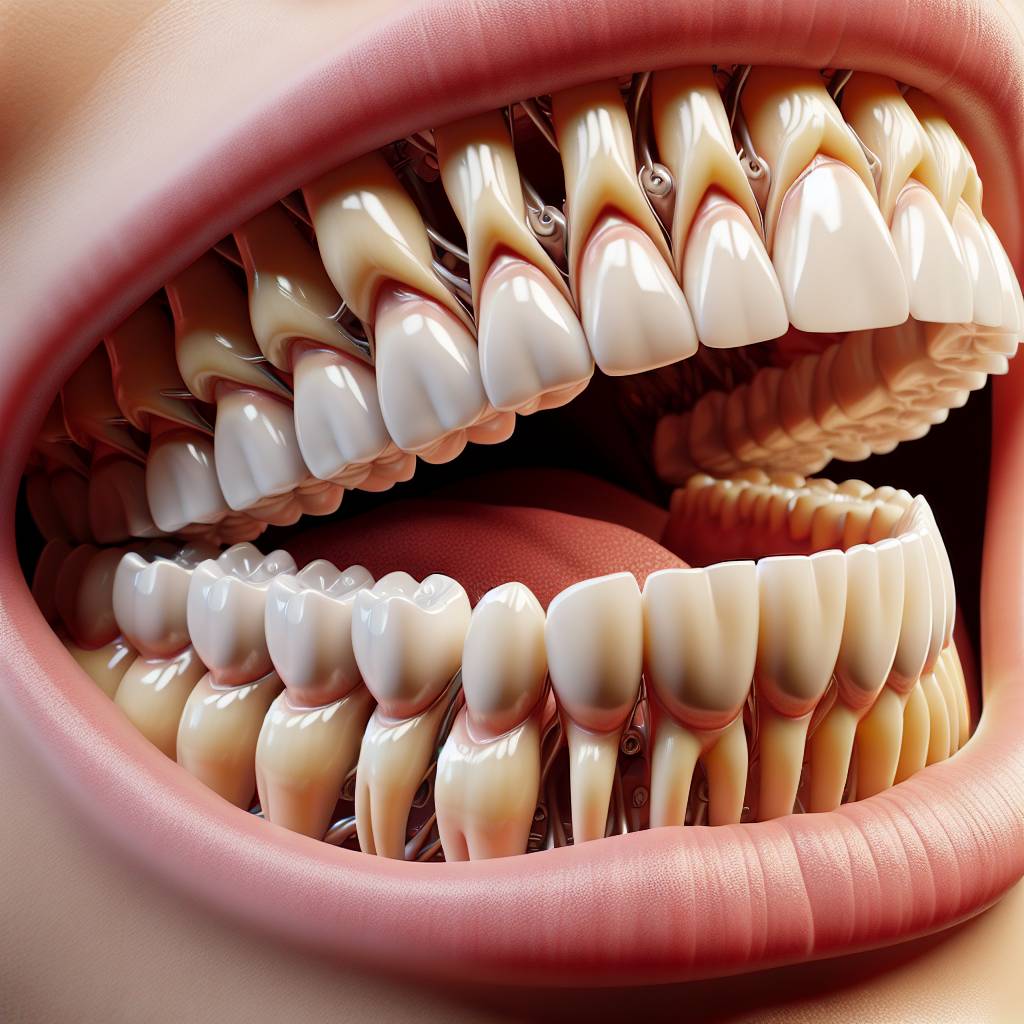A dental bridge can be an effective way to replace missing teeth. A bridge is a fixed prosthetic device that is anchored in place by adjacent teeth, implants, or a combination of both. The number of teeth that can be replaced with a bridge will depend on the overall condition of the patient’s mouth and the type of bridge being used.The number of teeth that can go on a bridge depends on the size and type of bridge being used. Generally, a bridge can support up to 4 missing teeth when the abutment teeth are healthy and properly prepared. If additional teeth need to be replaced, then multiple bridges may be needed.
What Is A Bridge In Dentistry?
A dental bridge is a type of restoration used to replace one or more missing teeth. It is typically comprised of two or more crowns that are attached to adjacent teeth (known as abutment teeth) and a false tooth in between, which is known as the pontic. The pontic is usually made from porcelain or porcelain fused to metal and is designed to mimic the appearance of a natural tooth. Bridges can be customized for color, shape, and size in order to blend in with the existing teeth. The bridge helps to restore the function and aesthetics of your smile, while also preventing the remaining teeth from shifting out of place.
Bridges may be recommended when multiple teeth are missing as it helps to support the overall structure of your mouth. The abutment teeth are typically prepared by removing some enamel so that a crown can be placed over them for additional stability. Once the bridge has been created, it will be permanently bonded into place. With proper care and maintenance, a bridge can last for many years without needing replacement.
The Benefits Of A Dental Bridge
A dental bridge is a restoration used to bridge the gap between two or more missing teeth. With this type of prosthetic, your dentist can restore the function and aesthetics of your smile. There are several benefits to getting a dental bridge, including:
Improved Appearance: A dental bridge helps restore the natural appearance of your smile by replacing missing teeth with prosthetic ones that look and feel like real teeth. The prosthetic is designed to match your existing teeth in color and shape, giving you a natural-looking smile.
Functionality: A dental bridge helps to restore the functionality of your mouth by filling gaps between missing teeth and preventing healthy teeth from shifting out of place. This helps you eat and speak more easily, allowing for normal functioning of your mouth.
Durability: Dental bridges are very durable, with some lasting up to 10 years or more with proper care. This makes them a long-lasting solution for restoring missing teeth and improving the aesthetics of your smile.
Overall Health Benefits: Filling gaps between missing teeth can help protect your overall oral health by preventing gum disease and decay from occurring in the empty space left behind. It also helps maintain proper alignment of remaining teeth and can reduce strain on other areas of your mouth caused by tooth loss.
Types Of Bridges Used In Dentistry
Dental bridges are a common treatment for replacing missing teeth. It is an economic and non-surgical way to fill the gap left in the smile by a single missing tooth or multiple missing teeth. Bridges are supported by natural teeth, dental implants, or a combination of both. The type of bridge used depends on the location and number of missing teeth, as well as the health of the surrounding teeth and gums. Here are some common types of bridges used in dentistry:
Traditional Bridges
Traditional bridges consist of a fabricated tooth which is held in place by dental crowns on either side. These crowns are placed on the adjacent teeth to support the bridge. The fabricated tooth fills in the space created by one or more missing teeth, restoring function and aesthetics to your smile. Traditional bridges are commonly used when there is adequate room between adjacent teeth to support them.
Cantilever Bridges
Cantilever bridges can be used when there is only one adjacent tooth available for support. The bridge is anchored to this single abutment tooth with one or more pontics (artificial teeth). This type of bridge is usually recommended when there are healthy adjacent teeth available, but not enough for traditional bridgework.
Maryland Bonded Bridges
Maryland bonded bridges, also known as resin-bonded bridges, use metal or porcelain wings that are attached to each side of the pontic (artificial tooth) to hold it in place. These wings are then bonded onto adjacent healthy teeth with resin cement, providing a secure fit without having to use crowns like with traditional bridgework. Maryland bonded bridges are typically used when there is not enough room for traditional bridgework and cantilever bridgework may cause too much stress on abutment teeth.
Implant-Supported Bridges
Implant-supported bridges use dental implants rather than natural teeth for support. This type of bridge requires two or more implants placed into your jawbone to provide secure support for your prosthetic replacement teeth. Implant-supported bridges provide superior stability compared to other types of bridgework and can be used even if all your natural teeth have been lost due to decay or injury.
No matter which type of bridge you choose, it’s important that you see an experienced dentist who can evaluate your circumstances and recommend the best option for restoring your smile and oral health.
What Is The Process For Receiving A Dental Bridge?
The process for receiving a dental bridge typically involves two or more visits to the dentist. During the first visit, the dentist will examine the patient’s mouth and take x-rays to determine the best course of action. The dentist will then discuss the options with the patient and explain what is involved, such as what type of bridge is needed and how it will be attached.
The next step is to prepare the teeth that will be used to support the bridge. This involves removing a small amount of enamel from each tooth so that a crown can be placed over them. The dentist may also need to make an impression of the teeth in order to create a model for the bridge.
Once the model has been created, it can be sent to a dental lab where the bridge will be custom-made. This usually takes several weeks. In some cases, a temporary bridge may be placed while waiting for the permanent one.
When the permanent bridge arrives at the dentist’s office, it will be checked for fit and any necessary adjustments made before being cemented into place by your dentist. Afterward, your dentist may suggest follow-up visits to monitor your progress and make sure everything is healing properly

Who Is Eligible For A Dental Bridge?
A dental bridge is a common restorative dental procedure that is used to replace missing teeth. The bridge is made up of two or more crowns for the teeth on either side of the gap, and a false tooth or teeth in between. To be eligible for a dental bridge, a patient must be missing one or more teeth and have healthy gums and enough bone structure to support the bridge.
The patient’s existing teeth must also be strong enough to support the bridge. The dentist will evaluate the patient’s oral health and take X-rays to determine if they are a candidate for a dental bridge. If there is not enough bone tissue remaining, then other options such as dental implants may be considered instead.
In addition, the patient must have good general health and be able to commit to diligent home care and regular dental visits. Patients with gum disease, diabetes, or other oral health issues may not be suitable candidates for a dental bridge.
Overall, anyone who is missing one or more teeth and has healthy gums and strong existing teeth may be eligible for a dental bridge. It is important to talk with your dentist about your eligibility and find out which option is best for you based on your individual needs.
Cost Of A Dental Bridge Procedure
The cost of a dental bridge procedure can vary significantly depending on several factors. These include the type of bridge being used, the number of teeth that need to be replaced, and any additional treatments that may be necessary. In general, traditional dental bridges tend to be the most expensive option as they require two separate visits to the dentist. The cost of a traditional dental bridge can range from $500 to $1,500 per tooth, with most patients paying an average of $1,100 per tooth.
Resin-bonded bridges are typically the least expensive option for replacing a single tooth because they only require one appointment and can cost between $250 and $750 per tooth. Cantilever bridges are also less costly than traditional bridges because only one side needs to be supported by an adjacent tooth. However, they are usually more expensive than resin-bonded bridges and can range from $600 to $1,200 per tooth.
In some cases, additional treatments may be necessary prior to the placement of a dental bridge such as root canal therapy or periodontal treatment. This will increase the overall cost of the procedure and should be discussed with your dentist before proceeding with treatment. Additionally, if you have dental insurance it is important to check what coverage is provided for the specific type of bridge being placed as this can greatly reduce your out-of-pocket expenses.
Overall, the cost for a dental bridge procedure can vary greatly depending on several factors such as the type of bridge used, number of teeth being replaced and any additional treatments required prior to placing the bridge. It is important to speak with your dentist about all these factors so that you have a better understanding of what costs you may incur for your specific situation.
Advantages Of A Dental Bridge Over Other Tooth Replacement Options
A dental bridge is a great option for replacing missing teeth. It has several advantages over other tooth replacement options, including the following:
1) Durability: A dental bridge is a durable solution and can last for many years. The bridge is made of material that is designed to withstand the pressures of chewing and normal wear and tear. This makes it a good option for people who want a long-term solution to replace missing teeth.
2) Natural Appearance: A dental bridge can be made to match the color, shape, and size of your natural teeth, making it virtually indistinguishable from your real teeth. This helps create an aesthetically pleasing smile that looks natural and beautiful.
3) Cost-Effectiveness: Dental bridges are generally more cost-effective than other tooth replacement options such as dentures or implants. This makes them an attractive option for people who want to replace their missing teeth without spending too much money.
4) Quick Procedure: The procedure for placing a dental bridge is relatively quick and easy compared to other tooth replacement options. It can usually be completed in one or two visits, making it an ideal choice for those who need their missing teeth replaced quickly.
Overall, a dental bridge is an excellent choice for replacing missing teeth as it offers many advantages over other tooth replacement options. It is durable, aesthetically pleasing, cost-effective, and can be completed quickly.

Conclusion
A bridge is an excellent way to replace missing teeth, as it can accommodate up to three or four teeth in a single restoration. The number of teeth that can go on a bridge is determined by the size and shape of the abutment teeth, as well as the number of missing teeth. It is important to note that bridges are not suitable for all cases and should only be done by an experienced dentist.
The success of a bridge depends on the oral health of the patient, and regular professional dental check-ups are essential in order to ensure the bridge remains functioning correctly. Bridges provide a strong, secure, and natural looking way to replace missing teeth and improve one’s smile. With proper care and maintenance, a bridge can last 10-15 years or more.
In summary, bridges are an ideal way to replace missing teeth and improve one’s smile. Bridges can accommodate up to three or four missing teeth in a single restoration, although this will depend on the size and shape of the abutment teeth. It is important for patients considering getting a bridge to consult with their dentist first in order to ensure they are suitable for this type of restoration. With proper care and maintenance, bridges provide excellent long-term results for replacing missing teeth.

